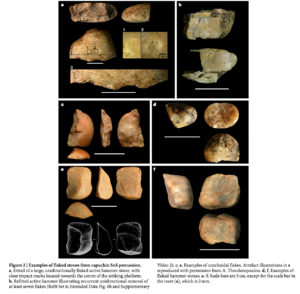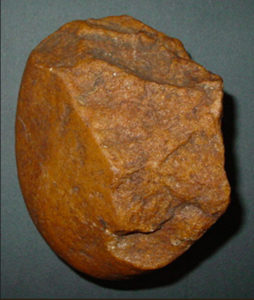
New World Monkeys Produce Hominin-Grade Lithic Tools
Nature 539 (2016): 85-88 doi:10.1038/nature20112
Wild monkeys flake stone tools
Proffitt, Tomos, Lydia V. Luncz, Tiago Falótico, Eduardo B. Ottoni, Ignacio de la Torre, and Michael Haslam
Our understanding of the emergence of technology shapes how we view the origins of humanity. Sharp-edged stone flakes, struck from larger cores, are the primary evidence for the earliest stone technology. Here we show that wild bearded capuchin monkeys (Sapajus libidinosus) in Brazil deliberately break stones, unintentionally producing recurrent, conchoidally fractured, sharp-edged flakes and cores that have the characteristics and morphology of intentionally produced hominin tools. The production of archaeologically visible cores and flakes is therefore no longer unique to the human lineage, providing a comparative perspective on the emergence of lithic technology. This discovery adds an additional dimension to interpretations of the human Palaeolithic record, the possible function of early stone tools, and the cognitive requirements for the emergence of stone flaking.
New World monkeys don’t cease to astonish. Phylogenetically most removed from modern humans, they nevertheless display a whole array of uniquely or predominantly human characteristics, among which most important are cooperative breeding, paternal investment, pair bonding, rudimentary language, and manual dexterity (see more here). Advanced manual dexterity was detected among genus Cebus, and now a new study of bearded capuchin monkeys from its sister genus Sapajus describes their sophisticated production of stone tools.
Wild chimpanzees are known to use stones to crack open nuts. Sometimes they accidentally chip off a stone piece in process. For a long time it was thought that first true stone tools appear with genus Homo in Africa (Oldowan culture) and the progressive evolution in lithic tool types has been a hallmark of human evolution. Recent discoveries in Africa (Harmand et al. “3.3-million-year-old stone tools from Lomekwi 3, West Turkana, Kenya.” Nature 521 (2015): 310-15) have provided evidence for an even earlier onset of deliberate stone tool production. Capuchin monkeys first surprised zoologists when it became obvious that they, too, just like chimpanzees, can use stones to open nuts (and they even use stone anvils for the job) (Fragaszy et al. “Wild Capuchin Monkeys (Cebus libidinosus) Use Anvils and Stone Pounding Tools”. American Journal of Primatology 64 (2004): 359-66). The evidence now is mounting to suggest that capuchin monkeys in fact exceed chimpanzees in their ability to intentionally produce stone tools. As Proffitt et al. (2016) write,
“[S]tone breakage during chimpanzee tool use is accidental, a result of missed hits or indirect force application during activities such as nut-cracking. The resulting stone fragments lack most of the diagnostic criteria listed above for hominin flakes. Even when the manufacture of sharp edges was taught to captive bonobos (Pan paniscus), the resulting flaked assemblage did not replicate the early hominin archaeological record.”
While humans are genetically different from bonobos by 1.2% and from capuchin monkeys by more than 10%, it’s the latter’s stone tool production skills that reach early hominin levels.
“Capuchin SoS [stone-on-stone.- G.D.] percussion flakes and flaked hammer-stones fall within the range of mean dimensions for simple flakes and cores from the Early Stone Age.”
Below are the examples of capuchin-produced “unifacial choppers” next to the famous Oldowan handaxe followed by a table of metric comparisons between capuchin tools and Pliocene-Pleistocene hominin tools from Africa (Proffitt et al. 2016, Extended Data Table 2b):
Not only have capuchins have falsified the fundamental premise of human cultural evolutionism, namely that manual dexterity and deliberate stone tool production separate humans from primates, they have also undermined the standards by which archaeologists identify human lithic activity. In addition to the traditional division of lithic finds into artifacts (human-produced stone tools) and geofacts (naturally modified stone), archaeologists will now have to differentiate between anthropoartifacts and zooartifacts. On the one hands, some of the lithic finds proposed as evidence of ancient human habitation in South America may end up being products of capuchin labor. On the other hand, some of the lithic finds that don’t meet the Old World hominin criteria for an artifact may nevertheless have been utilized by modern humans. The visible boundaries between humans and primates have become murkier.





Now we need to explain why less refined core tools found in the Americas are often associated with “stone lined hearths” a technology missing in earlier homo finds until Hss arrived on the scene.